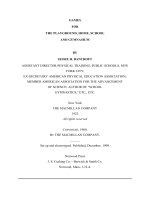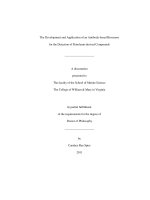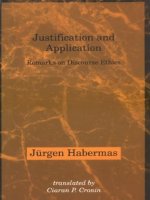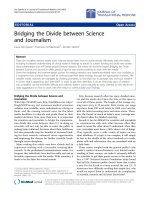- Trang chủ >>
- Khoa Học Tự Nhiên >>
- Vật lý
The J-Matrix Method Development and Application potx
Bạn đang xem bản rút gọn của tài liệu. Xem và tải ngay bản đầy đủ của tài liệu tại đây (7.66 MB, 359 trang )
The J-Matrix Method
Abdulaziz D. Alhaidari · Eric J. Heller ·
Hashim A. Yamani · Mohamed S. Abdelmonem
Editors
The J-Matrix Method
Developments and Applications
Foreword by Hashim A. Yamani and Eric J. Heller
Editors
Abdulaziz D. Alhaidari
Shura Council
Riyadh 11212
Saudi Arabia
Eric J. Heller
Harvard University
Dept. of Chemistry & Physics
17 Oxford street
Cambridge MA 02138-2901
USA
Hashim A. Yamani
Ministry of Commerce &
Industry
Riyadh 11127
Saudi Arabia
Mohamed S. Abdelmonem
King Fahd University
of Petroleum & Minerals
Dept. of Physics
Dhahran 31261
Saudi Arabia
ISBN: 978-1-4020-6072-4 e-ISBN: 978-1-4020-6073-1
Library of Congress Control Number: 2008921100
c
2008 Springer Science+Business Media B.V.
No part of this work may be reproduced, stored in a retrieval system, or transmitted
in any form or by any means, electronic, mechanical, photocopying, microfilming, recording
or otherwise, without written permission from the Publisher, with the exception
of any material supplied specifically for the purpose of being entered
and executed on a computer system, for exclusive use by the purchaser of the work.
Printed on acid-free paper
987654321
springer.com
Foreword
Although introduced 30 years ago, the J-matrix method has witnessed a resurgence
of interest in the last few years. In fact, the interest never ceased, as some authors
have found in this method an effective way of handling the continuous spectrum
of scattering operators, in addition to other operators. The motivation behind the
introduction of the J -matrix method will be presented in brief.
The introduction of fast computing machines enabled theorists to perform calcu-
lations, although approximate, in a conveniently short period of time. This made it
possible to study varied scenarios and models, and the effects that different possible
parameters have on the final results of such calculations. The first area of research
that benefited from this opportunity was the structural calculation of atomic and
nuclear systems. The Hamiltonian element of the system was set up as a matrix in a
convenient, finite, bound-state-like basis. A matrix of larger size resulted in a better
configuration interaction matrix that was subsequently diagonalized. The discrete
energy eigenvalues thus obtained approximated the spectrum of the system, while
the eigenfunctions approximated the wave function of the resulting discrete state.
Structural theorists were delighted because they were able to obtain very accurate
values for the lowest energy states of interest.
Of course, the result of diagonalization also gives information on the remain-
ing discrete states, including those that lie in the energy continuum. The fact that
the approximation yields ‘discrete’ scattering states could not be helped, since the
Hamiltonian is represented by a finite matrix. The situation is worsened by the fact
that the eigenfunctions of these “discrete” continuum states are bound-state-like, as
all members of the basis set used in constructing the Hamiltonian have this property.
This was deemed unnatural, and led theorists to believe that this data did not consti-
tute information that was useful for the calculation of scattering. This belief almost
put a stop to the application of basis-set techniques for the solving of scattering
problems. However, a major turnaround occurred as a result of the work by Hazi
and Taylor [1].
Hazi and Taylor took the natural step of asking whether a use could be made of
the bound-state-like basis to describe resonances, which resemble bound states even
though they are actually scattering states. This led to the “Stabilization method”:
real discrete energy eigenvalues closest to the resonance energy become stable as
the parameters of the calculation are varied. This development rekindled confidence
v
vi Foreword
among theorists for the belief that the discrete energy eigenvalues and eigenfunc-
tions may indeed contain useful information about the continuous spectrum of the
Hamiltonian.
The Reinhardt group at Harvard was in the meantime developing a computational
scheme to extract scattering information from the Fredholm determinant [2]. For a
given short range potential V , the Fredholm determinant D(z)isdefinedas:
D(z) = det
z − H
z − H
0
,
with the phase of D(z) being the negative of the phase shift δ(E) in the limit z →
E +iε. It also satisfies the dispersion relation
D(z) = 1 +
∞
0
A(E)
z − E
dE
where D(E + iε) = d(E) − iπ A(E), and the functions d(E)andA(E) are both
real and analytic. Encouraged by the stabilization results, the group worked with the
matrix representation of H and H
0
in a finite L
2
-basis set,
{
φ
n
}
N−1
n=0
. Therefore, the
Fredholm determinant has the approximate value
D
approx
(z) =
N−1
i=0
z − E
i
z − E
0
i
,
where
{
E
i
}
N−1
i=0
and
E
0
i
N−1
i=0
are the eigenvalues of the finite matrices
˜
H and
˜
H
0
,
respectively. The above equation can be cast in the form
D
approx
(z) = 1 +
N−1
i=0
⌫
i
z − E
0
i
,
which resembles a quadrature approximation to the above dispersion relation with
the set
E
0
i
N−1
i=0
containing the abscissas. Furthermore, Schwartz observed that if
the basis
{
φ
n
}
N−1
n=0
is a certain Laguerre functions, then the abscissas fall as the
transformed zeros of an orthogonal polynomial with known properties [3]. These
facts enabled the group to calculate D
approx
(E + iε) and obtain accurate scattering
results.
This development added some analytical tools to the predominant numerical
tools available for use in the L
2
-Fredholm method. For instance, the discrete eigen-
function of the finite N × N Hamiltonian H
0
may now be written as a finite sum of
L
2
-basis, with the orthogonal polynomials as Fourier-like expansion coefficients:
Foreword vii
|
ψ
N
(E)
= B
N
(E)
N−1
n=0
P
n
(E)
|
φ
n
where P
n
(E) is the orthogonal polynomial such that P
N
(E
0
i
) = 0.
Heller of the Reinhardt group, who was also studying ways of enhancing the
R-matrix method of scattering, proposed a way to improve the accuracy of the L
2
-
Fredholm calculation. He first proposed that the exact sine-like solution of the ref-
erence Hamiltonian H
0
be expanded in the complete L
2
-basis. This could formally
be done since the Fourier-like expansion coefficients were obtainable, even analyt-
ically. Similar to the R-matrix method, but unlike the L
2
Fredholm method, this
approach made it possible to take full account of the reference Hamiltonian H
0
by
giving a full solution of the reference problem in the complete basis. Furthermore,
in the spirit of the R-matrix method, Heller and Yamani proposed that the potential
representation be limited to a finite subset of the complete basis. This is the basic
idea behind the J-matrix method [4], so called because the matrix representation
of the operator J = H
0
− E in certain Laguerre or oscillator basis functions is
tridiagonal (Jacobi).
The analogy with the R-matrix method [5] is strong. The language of the R-
matrix in configuration space is translated for the J -matrix into the language of
function space. The full model Hamiltonian and wavefunction are written for the
R-matrix method and J-matrix method as follows, in their respective languages:
˜
H =
H
0
+ V (r) r ≤ R
H
0
r > R
→
˜
H
nm
=
(H
0
)
nm
+ V
nm
n, m ≤ N − 1
(H
0
)
nm
n, m > N − 1
whereas in a pictorial representation it looks as follows
˜
H − E ∼
⎛
⎜
⎜
⎜
⎜
⎜
⎜
⎜
⎜
⎜
⎜
⎜
⎜
⎜
⎜
⎝
×××···· × | 0
×××···· × | 00
::: : | :
×××···· × |J
N−1,N
000········
——— — — | —— — ———
000····J
N,N −1
| J
N,N
J
N+1,N+1
0 | J
N+1,N
J
N+1,N+1
J
N+1,N+2
0
00| J
N+2,N+1
J
N+2,N+2
J
N+2,N+3
: | ···· ···· ····
: | 0 ·· ·· · ··· · ···
⎞
⎟
⎟
⎟
⎟
⎟
⎟
⎟
⎟
⎟
⎟
⎟
⎟
⎟
⎟
⎠
If we expand the solution ψ(E, r) in the complete basis as ψ(E, r) =
∞
n=0
f
n
(E)
φ
n
(r), then
viii Foreword
ψ(E, r) =
ψ(E, r) r ≤ R
1
√
k
e
−ikr
− S(E)e
ikr
r > R
→
f
n
=
f
n
n, m ≤ N − 1
1
√
k
[(c
n
−is
n
) − S(E)(c
n
+is
n
)] n, m > N − 1
where s
n
and c
n
are the expansion coefficients of the sine-like and cosine-like solu-
tions of the reference Hamiltonian in the complete L
2
basis. In both methods, the
resulting scattering matrix S(E) is exact for the approximate model Hamiltonian
˜
H.
This contrasts with the use of variational schemes to solve the scattering problem,
which basically seek an approximate solution to the exact Hamiltonian H . The latter
methods sometimes lead to the existence of anomalous pseudo-resonance behavior
of the calculated cross sections. This phenomenon is not present in J -matrix calcu-
lations [6].
An example of a closed form solution provided by the J-matrix method is the
explicit result for the exact S-matrix of a truncated potential:
S(E) =
(c
N−1
−is
N−1
) + g
N−1,N−1
(E)J
N−1,N
(E)(c
N
− is
N
)
(c
N−1
+is
N−1
) + g
N−1,N−1
(E)J
N−1,N
(E)(c
N
+ is
N
)
Here g
N−1,N−1
(E)isthe(N−1,N−1) element of the inverse of the matrix represen-
tation of (H − E) in the finite basis, and J
nm
(E) ≡ (H
0
− E)
nm
. Results show that
S(E) is a highly accurate approximation of the S-matrix of the exact Hamiltonian.
Most notably, S(E) has the following two desirable properties:
(a) S(E) is a smooth function of E, even as it assumes the values of the eigenvalues
{
E
i
}
N−1
i=0
or
E
0
i
N−1
i=0
. In fact, at the points
{
E
i
}
N−1
i=0
, S(E) has the special value
S(E
i
) =
c
N
−is
N
c
N
+is
N
E=E
i
This is a noteworthy result, which states that the S-matrix (cross section, or
phase shift) for the approximate Hamiltonian
˜
H could be calculated exactly, at
positive discrete energies, by knowing only the coefficients of the wavefunc-
tion of the reference Hamiltonian H
0
in the basis. Yamani and Abdelmonem
took the set
{
S(E
i
)
}
N−1
i=0
, representing the value of S(E) on the real (scattering)
energy axis, and analytically continued it to the lower complex energy plane
to search for shallow resonances [7]. These are characterized by poles of S(z)
in the second sheet of the complex energy plane. The same authors showed
that a similar, and slightly more complicated result, holds in the multi-channel
case [7].
(b) The diagonalization of H in the finite L
2
basis needs to be done only once to
enable the calculation of S(z) over the entire continuum range of energy.
Foreword ix
The first application of the J-matrix method was in the Tempkin-Poet model
of an S-wave e-H scattering analysis [8]. The target and incoming projectile are
described on the same basis, resulting in a finite number of target channels. A six-
state calculation was able to reproduce previous results using different theoretical
methods, and the calculation improved when the finite basis was enlarged. Implicit
in this model is the approximation of the target by a finite number of channels;
some, if any, represent the bound states, while the rest represent the continuum
of scattering states. This naturally leads to anomalous behavior of the scattering
cross section when the scattering energy is increased, so that more discrete chan-
nels become “open.” Of course, this should not be the case. The correction of this
anomalous behavior is still an outstanding problem for the J-matrix method and
for similar methods that approximate the target ionization region by a finite num-
ber of channels. Bray and Stelbovics showed that the anomalous behavior tends to
disappear as the number of target channels is increased [9].
Another early application of the J-matrix method of scattering was carried out by
Broad and Reinhardt, who calculated e-H
−
scattering cross-sections and accurately
reproduced resonance positions [10].
Further developments in the J -matrix method ensued:
(1) The matrix elements of Green’s function associated with the reference Hamil-
tonian H
0
were evaluated by Heller, showing the analogy to the configuration
space result [6]:
G
0
(r, r
) =
2
k
sin(kr
<
)e
ikr
>
→ G
0
nm
=
φ
n
|
G
|
φ
m
=
2
k
s
n
<
(c
n
>
+ is
n
>
)
where n
<
(n
>
) is the smaller (larger) of n and m. Heller also showed that if the
regular and irregular J-matrix solutions are written, respectively, as
|
ψ
R
(E)
=
n
R
n
(E)
|
φ
n
,
|
ψ
I
(E)
=
n
I
n
(E)
|
φ
n
,
Green’s function is then given as
G
nm
(E) =
2
k
R
n
<
(I
n
>
+iR
n
>
)
(2) Yamani and Abdelmonem generalized these results to the multi-channel case.
However, they adopted a different approach that cast the results in terms of the
finite Green’s function g
N−1,N−1
(E) and only considered quantities associated
with G
0
(E) [11]. In so doing, they showed that the Lippman-Schwinger equa-
tion T = V – VGV could be solved over a continuous range of energies, without
re-diagonalization of matrices every time the energy is varied.
(3) Horodecki achieved a relativistic generalization of the J-matrix method [12].
This generalization was refined by Alhaidari et al. [13].
x Foreword
(4) Yamani et al. made an important generalization of the J -matrix method to any
convenient L
2
-basis, without any significant loss of the advantages provided by
the method [14].
(5) Vanroose et al. [15] enhanced the method, especially in the treatment of long
range potentials, by introducing additional terms in the three-term recursion
relation that takes into account the asymptotic behavior of the potential.
(6) Alhaidari et al. [16] present an alternative, but equivalent, approach to the regu-
larization of the reference problem in the J -matrix method. It is an integration
approach, which was found to be more direct and transparent than the classical
differential approach. They also developed the relativistic J-matrix method of
scattering for spin
1
2
Dirac projectile with position-dependent mass [17].
The contributions in the present volume are aimed at giving a brief account of
recent developments, and some selected applications, of the method in atomic and
nuclear physics:
In Part II, convergence issues are revisited by Igashove who makes a compre-
hensive study of the convergence of the Fourier expansion of the wavefunction in
the oscillator basis. After investigating the effects of the regularization procedure on
convergence, Broeckhove et al. propose an alternative regularization approach in the
J-matrix method and demonstrate the resulting improvements. On the other hand,
a method for the accurate evaluation of the S-matrix for multi-channel analytic and
non-analytic potentials in complex L
2
bases is presented in the same Section by
Yamani and Abdelmonem. Using the tools of the relativistic J -matrix, Alhaidari
obtains analytic expressions for the scattering phase shift of separable potentials
with Laguerre-type form factors. Shirokov and Zaytsev study an interesting problem
that is best addressed in the language of the J-matrix. They show that non-local in-
teraction models could result in “isolated bound states” embedded in the continuum
with positive as well as negative energy.
In Part III, Knyr et al. use the J-matrix method as a universal approach for the
description of the process involving the ionization of atoms. They succeed in ad-
dressing the difficult problem of correctly describing the continuous spectrum eigen-
functions in the scattering of three charged particles using the J-matrix method.
Papp exploits the J-matrix structure of the Coulomb Green’s matrix to solve the
Faddeev-type integral equations of the three-body Coulomb problem. In the arti-
cle by Yamani and Abdelmonem, three approximation methods are proposed that
endow the complex scaling method with the ability to compute resonance partial
widths for multi-channel problems.
In Part IV, Lurie and Shirokov give a review of their recent work on the three-
body loosely-bound nuclear systems within the J-matrix approach with an extended
oscillator basis. They apply their investigation to
11
Li and
6
He nuclei. Furthermore,
Shirokov et al. construct the nucleon–nucleon interaction by means of the J-matrix
version pertaining to inverse scattering theory, where they eliminate the problem of
ambiguity of the interaction by postulating tridiagonal and quasi-tridiagonal forms
of the potential matrix. In the same Section, Arickx et al. use their proposal of
modifying the J-matrix method (to account for coupling to long range interactions)
Foreword xi
to cluster descriptions of light nuclei. The method is applied to
6
He and
6
Be nuclei
for scattering and reaction problems. Finally, in Part V, Johnson and Holder present
a generalization of the density functional theory, which is widely used in chemical
physics applications, using a theoretical framework whose structure parallels that of
the J -matrix method.
It is the hope of the editors that this volume will provide the interested reader
with enough material for him or her to appreciate the advantages of the J -matrix
method, and to encourage its use and development into a viable method for theoret-
ical calculation of nuclear and atomic systems.
Riyadh Hashim A. Yamani
Cambridge, Massachusetts Eric J. Heller
References
1. A. U. Hazi and H. S. Taylor, Phys. Rev. A 2, 1109 (1970)
2. W. P. Reinhardt, D. W. Oxtoby, and T. N. Rescigno, Phys. Rev. Lett. 28, 401 (1972);
T. S. Murtaugh and W. P. Reinhardt, J. Chem. Phys. 57, 2129 (1972)
3. C. Schwartz, Ann. Phys. (NY) 16, 36 (1960)
4. E. J. Heller and H. A. Yamani, Phys. Rev. A 9, 1201 (1974); H. A. Yamani and L. Fishman,
J. Math. Phys. 16, 410 (1975)
5. A. M. Lane and R. G. Thomas, Rev. Mod. Phys. 30, 257 (1958); A. M. Lane and D. Robson,
Phys. Rev. 178, 1715 (1969)
6. E. J. Heller, Phys. Rev. A 12, 1222 (1975)
7. H. A. Yamani and M. S. Abdelmonem, J. Phys. A 26, L1183 (1993); 27, 5345 (1994); 28,
2709 (1996); 29, 6991 (1996)
8. E. J. Heller and H. A. Yamani, Phys. Rev. A 9, 1209 (1974)
9. I. Bray and A. T. Stelbovics, Phys. Rev. Lett. 69, 53 (1992)
10. J. T. Broad and W. P. Reinhardt, J. Phys. B 9, 1491 (1976)
11. H. A. Yamani and M. S. Abdelmonem, J. Phys. B, 30, 1633 (1997); 30, 3743 (1997)
12. P. Horodecki, Phys. Rev. A 62, 052716 (2000)
13. A. D. Alhaidari, H. A. Yamani, and M. S. Abdelmonem, Phys. Rev. A 63, 062708 (2001)
14. H. A. Yamani, A. D. Alhaidari, and M. S. Abdelmonem, Phys. Rev. A 64, 042703 (2001)
15. W. Vanroose, J. Broeckhove, and F. Arickx, Phys. Rev. Lett. 88, 010404 (2002)
16. A. D. Alhaidari, H. Bahlouli, M. S. Abdelmonem, F. Al-Ameen, and T. Al-Abdulaal, Phys.
Lett. A 364, 372 (2007)
17. A. D. Alhaidari, H. Bahlouli, A. Al-Hasan, and M. S. Abdelmonem, Phys. Rev. A 75, 062711
(2007)
Contents
Part I Two of the Original Papers
New L
2
Approach to Quantum Scattering: Theory 3
Eric J. Heller and Hashim A. Yamani
J-Matrix Method: Extensions to Arbitrary Angular Momentum
and to Coulomb Scattering 19
Hashim A. Yamani and Louis Fishman
Part II Theoretical and Mathematical Considerations
Oscillator Basis in the J-Matrix Method: Convergence of Expansions,
Asymptotics of Expansion Coefficients and Boundary Conditions 49
S.Yu. Igashov
Scattering Phase Shift for Relativistic Separable Potentials
with Laguerre-Type Form Factors 67
A.D. Alhaidari
Accurate Evaluation of the S-Matrix for Multi-Channel Analytic
and Non-Analytic Potentials in Complex L
2
Bases 83
H.A. Yamani and M.S. Abdelmonem
J-Matrix and Isolated States 103
A.M. Shirokov and S.A. Zaytsev
On the Regularization in J-Matrix Methods 117
J. Broeckhove, V.S. Vasilevsky, F. Arickx and A.M. Sytcheva
xiii
xiv Contents
Part III Applications in Atomic Physics
The J-Matrix Method: A Universal Approach to Description
of Ionization of Atoms 137
V.A. Knyr, S.A. Zaytsev, Yu.V. Popov and A. Lahmam-Bennani
J-Matrix Green’s Operators and Solving Faddeev Integral Equations
for Coulombic Systems 145
Z. Papp
The Use of a Complex Scaling Method to Calculate Resonance
Partial Widths 173
H.A. Yamani and M.S. Abdelmonem
Part IV Applications in Nuclear Physics
J-Matrix Approach to Loosely-Bound Three-Body Nuclear Systems 183
Yu.A. Lurie and A.M. Shirokov
Nucleon–Nucleon Interaction in the J-Matrix Inverse Scattering
Approach and Few-Nucleon Systems 219
A.M. Shirokov, A.I. Mazur, S.A. Zaytsev, J.P. Vary and T.A. Weber
The Modified J-Matrix Approach for Cluster Descriptions
of Light Nuclei 269
F. Arickx, J. Broeckhove, A. Nesterov, V. Vasilevsky and W. Vanroose
Part V Other Related Methods: Chemical Physics Application
A Generalized Formulation of Density Functional Theory with Auxiliary
Basis Sets 311
Benny G. Johnson and Dale A. Holder
Index 353
Contributors
M.S. Abdelmonem
Physics Department, King Fahd University of Petroleum and Minerals, Dhahran
31261, Saudi Arabia
A.D. Alhaidari
Shura Council, Riyadh 11212, Saudi Arabia
F. Arickx
University of Antwerp, Group Computational Modeling and Programming,
Antwerp, Belgium,
J. Broeckhove
University of Antwerp, Group Computational Modeling and Programming,
Antwerp, Belgium
L. Fishman
Department of Chemistry, Harvard University, Cambridge, MA 02138, USA
Eric J. Heller
Department of Chemistry and Physics, Harvard University, Cambridge, MA 02138,
USA
Dale A. Holder
Quantum Simulations, Inc., 5275 Sardis Road, Murrysville, PA 15668, USA
S.Yu. Igashov
Moscow Engineering Physics Institute, Kashirskoe sh. 31, Moscow 115409, Russia
xv
xvi Contributors
Benny G. Johnson
Quantum Simulations, Inc., 5275 Sardis Road, Murrysville, PA 15668, USA
V.A. Knyr
Pacific National University, Khabarovsk, Russia
knyr@fizika.khstu.ru
A. Lahmam-Bennani
Lab. des Collisions Atomiques et Mol´eculaires, Universit´e de Paris-Sud XI, 91405
Orsay Cedex, France
Yu.A. Lurie
The College of Judea and Samaria, Ariel 44837, Israel
A.I. Mazur
Physics Department, Pacific National University, Tikhookeanskaya 136,
Khabarovsk 680035, Russia
A. Nesterov
Bogolyubov Institute for Theoretical Physics, Kiev, Ukraine
Z. Papp
Department of Physics and Astronomy, California State University, Long Beach,
CA 90840, USA
Yu.V. Popov
Nuclear Physics Institute, Moscow State University, Moscow, Russia
A.M. Shirokov
Skobeltsyn Institute of Nuclear Physics, Moscow State University, Moscow
119992, Russia
A.M. Sytcheva
University of Antwerp, Group Computational Modeling and Programming,
Antwerp, Belgium
Contributors xvii
W. Vanroose
University of Antwerp, Group Computational Modeling and Programming,
Antwerp, Belgium
J.P. Vary
Department of Physics and Astronomy, Iowa State University, Ames, IA
50011-3160, USA
V.S. Vasilevsky
Bogolyubov Institute for Theoretical Physics, Kiev, Ukraine
T.A. Weber
Department of Physics and Astronomy, Iowa State University, Ames, IA
50011-3160, USA
H.A. Yamani
Ministry of Commerce & Industry, P.O. Box 5729, Riyadh 11127, Saudi Arabia
S.A. Zaytsev
Physics Department, Pacific National University, Tikhookeanskaya 136,
Khabarovsk 680035, Russia
, zaytsev@fizika.khstu.ru
Part I
Two of the Original Papers
New L
2
Approach to Quantum
Scattering: Theory
Eric J. Heller and Hashim A. Yamani
∗
Abstract By exploiting the soluble infinite tridiagonal (Jacobi)-matrix problem
generated by evaluating a zero-order scattering Hamiltonian H
0
in a certain L
2
basis set, we obtain phase shift, wave functions, etc., which are exact for a full
Hamiltonian H in which only the potential V is approximated. Only bound–bound
(L
2
) matrix elements of the Hamiltonian and finite matrix manipulations are needed.
The method is worked out here for s-wave scattering using Laguerre basis functions.
Kato improvement of the results and necessary generalizations to many channels are
treated.
1 Introduction
In atomic and nuclear scattering, it is often desirable to use Slater (Laguerre) or
oscillator (Hermite) basis functions. This chapter is the first of several in which we
present a new method for performing scattering calculations entirely with square-
integrable (L
2
) functions. We develop techniques in which we attempt to take full
advantage of the analytic properties of a given Hamiltonian and also of the L
2
basis which is used to describe the wave function. Specifically, in what follows,
we develop the basic theory using Laguerre-type basis functions appropriate for
s-wave scattering. In the following chapter [1], we will apply the method to electron-
hydrogen elastic s-wave scattering below the n= 2 threshold, and to inelastic radial-
limit scattering calculations above and below the ionization threshold.
Our basic approach is to treat an uncoupled Hamiltonian H
0
exactly in the space
spanned by the complete L
2
basis. The remaining part of the Hamiltonian (i.e., the
E.J. Heller
Department of Chemistry and Physics, Harvard Univeristy, Cambridge, MA 02138, USA
e-mail:
∗
Supported by a fellowship from the College of Petroleum and Minerals, Dhahran, Saudi Arabia.
Reprinted with permission from:
E.J. Heller and H.A. Yamani, New L2 Approach to Quantum Scattering: Theory, Phys. Rev. A 9,
1201–1208, (1974). Copyright (1974) by the American Physical Society.
/>A.D. Alhaidari et al. (eds.), The J-Matrix Method, 3–17. 3
C
Springer Science+Business Media B.V. 2008
4 E.J. Heller, H.A. Yamani
potential) is approximated to some desired degree of accuracy, V
approx
, such that the
resulting Hamiltonian H
0
+V
approx
is also exactly soluble in the complete L
2
space.
Phase shifts and cross sections can then be extracted from the resulting wave func-
tion ψ
E
. This wave function has the desirable property of being an exact solution
to a well-defined scattering Hamiltonian. If V
approx
is a good representation of the
exact potential, and if second-order accuracy is desired, then ψ
E
may be considered
as a trial wave function in the standard variational formulas.
By an exact solution χ
E
to the Hamiltonian H
0
+ V , we mean of course,
(H
0
+ V − E)
|
χ
E
= 0. (1)
In a space of complete L
2
functions
{
φ
n
}
,whereχ
E
is expanded as χ
E
=
∞
0
b
n
φ
n
,
Eq. (1) is equivalent to
φ
m
|
(H
0
+ V − E)
|
χ
E
= 0(2)
for all m = 0, 1, 2, ∞. For most potentials considered in scattering theory, it will
not be possible to satisfy Eq. (2).
However, consider the basis set
{
φ
m
}
∞
m=0
such that
φ
m
(r) = (λr)e
−λr
/
2
L
1
m
(λr), (3)
where λ is a scaling parameter. In Section 2.1, we show that by writing χ
0
E
=
∞
0
b
0
n
φ
n
, the similar equation
φ
m
|
(H
0
− E)
χ
0
E
= 0, m = 0, 1, ,∞ (4)
where H
0
=−
1
2
d
2
dr
2
, leads to a soluble Jacobi-matrix problem for the b
0
n
’s. The
properties of the Jacobi matrix representation of H
0
in the L
2
basis play a central
role in our method. For this reason we call our approach the Jacobi (or J-) matrix
method.
In Section 2.2, we construct a solution ψ
E
for
φ
m
|
H
0
+ V
N
− E
|
ψ
E
= 0, m = 0, 1, ,∞ (5)
where V
N
is an N × N matrix representation of V in the set
{
φ
n
}
, thus achieving
the goal of obtaining an exact solution to the Hamiltonian with an approximating
potential. In Section 3, we employ this wave function as a trial function in the
Kato variational formula [2]. In Section 4, the necessary extension to multi-channel
scattering is developed. In Section 5, a brief discussion is presented.
New L
2
Approach to Quantum Scattering: Theory 5
2 Potential Scattering
2.1 The Unperturbed Hamiltonian H
0
Our task in this section is to determine the coefficients b
0
n
of the expansion of χ
0
E
in
Eq. (4) in terms of our basis set
{
φ
n
}
. Substituting the expansion for χ
0
E
in Eq. (4)
results in an infinite matrix problem for the set {b
0
n
}:
J · b
0
= 0, (6)
where J is the matrix
J
nm
=
∞
0
φ
n
(r)
−
1
2
d
2
dr
2
− E
φ
m
(r)dr
=−
1
λ
(n + 1)(m +1)
E +
λ
2
8
2xδ
n,m
− δ
n,m−1
− δ
n,m+1
,
(7)
where x =
E −
λ
2
8
E +
λ
2
8
. Note that J is an infinite tridiagonal (Jacobi)
matrix. Equation (6) is thus a three-term recursion relation for the s
n
’s [where b
0
n
=
s
n
(n + 1)]oftheform
2xs
n
− s
n−1
− s
n+1
= 0, for n ≥ 1, (8a)
with the initial relation
2xs
0
− s
1
= 0, for n = 0. (8b)
Equation (8a), being a second-order difference equation, naturally has two lin-
early independent solutions. However, Eq. (8b) provides a boundary condition and
thereby completely determines the s
n
’s. Equation (8a) is the recursion relation sat-
isfied by the Chebyschev polynomials [3], and Eq. (8b) gives us those polynomials
of the second kind. Therefore, we may write
s
n
= sin(n + 1)θ, (9)
where cos θ = x =
E −
λ
2
8
E +
λ
2
8
. s
n
sin θ is then an nth-order polynomial
in x. A similar analysis of H
0
in the basis
{
φ
n
}
has been provided by Schwartz [4].
The expression for χ
0
E
then becomes
r
χ
0
E
=
∞
n=0
s
n
n + 1
φ
n
(r) =
∞
n=0
sin(n + 1)θ
n + 1
φ
n
(r). (10)
6 E.J. Heller, H.A. Yamani
Since we have now solved Eq. (4) exactly in the basis set, it is not surprising that
the s
n
’s are simply the expansion coefficients of sinkr (with E =
1
2
k
2
)intermsof
the φ
n
’s [5]. Note that although we have used a discrete (L
2
)basis,H
0
nonetheless
has a continuous spectrum. This stems from the fact that the set
{
φ
n
}
is infinite and
complete in r on [0,∞].
For the purpose of Section 2.2, we will require an independent solution of the
three-term recursion relation (8a). Specifically, we wish to find a set
{
c
n
}
such that
the function
˜
C(r) =
∞
n=0
c
n
n + 1
φ
n
(r)
behaves as coskr when r →∞. Since the c
n
’s form an independent solution to
Eq. (8a), they satisfy the following equation:
2xc
n
− c
n−1
− c
n+1
= 0, n ≥ 1(8c)
with the boundary condition
2xc
0
− c
1
= β = 0. (8d)
It is easy to verify, because β is non-vanishing, that the differential equation satisfied
by
˜
C(r)is
(H
0
− E)
˜
C(r) =−β
E +
λ
2
8
e
−λr
/
2
. (11)
By employing the Green’s function g(r, r
) = (2 sin kr
<
cos kr
>
)
k it can be readily
shown that the solution to Eq. (11) is
˜
C(r) =−
2β
k
E +
λ
2
8
×
⎡
⎣
⎛
⎝
r
0
sin kr
e
−λr
/
2
dr
⎞
⎠
cos kr +
⎛
⎝
∞
r
cos kr
e
−λr
/
2
dr
⎞
⎠
sin kr
⎤
⎦
which upon carrying out the integration, reduces to
˜
C(r) =−β
cos kr −e
−λr
/
2
. (12)
The requirement that
˜
C(r) → cos(kr)asr →∞means that β =−1. With this
value for β, it is easily verified that c
n
=−cos(n +1)θ satisfies Eqs. (8c) and (8d).
Therefore,
˜
C(r) now reads
New L
2
Approach to Quantum Scattering: Theory 7
˜
C(r) = coskr − e
−λr
/
2
=−
∞
n=0
cos(n + 1)θ
n + 1
φ
n
(r). (13)
Note the interesting property that
˜
C(r) behaves regularly at the origin.
2.2 Adding an Approximating Potential
One way to introduce an approximation to V is to truncate the representation of V
in the basis
{
φ
n
}
to an N × N matrix; we call this new potential V
N
:
V
N
nm
=
∞
0
φ
n
(r)V (r)φ
m
(r)dr, n, m ≤ N − 1
= 0, otherwise.
(14)
Our task is to solve
φ
m
|
H
0
+ V
N
− E
|
ψ
E
= 0, m = 0, 1, ,∞ (15)
Where ψ
E
=
∞
n=0
d
n
φ
n
(r). Schematically, these equations look like
01••N − 1 NN+ 1 ••
0
1
•
•
N − 1
N
N + 1
•
•
⎡
⎢
⎢
⎢
⎢
⎢
⎢
⎢
⎢
⎢
⎢
⎢
⎢
⎢
⎢
⎢
⎢
⎢
⎢
⎣
XXXXX|
XXXXX|
XXXXX| 0
XXXXX|
XXXXX| X
—————| ——————
X | XX
| XXX 0
0 | XXX
|•
| 0 •
|•
⎤
⎥
⎥
⎥
⎥
⎥
⎥
⎥
⎥
⎥
⎥
⎥
⎥
⎥
⎥
⎥
⎥
⎥
⎥
⎦
⎡
⎢
⎢
⎢
⎢
⎢
⎢
⎢
⎢
⎢
⎢
⎢
⎢
⎢
⎢
⎢
⎢
⎢
⎢
⎣
d
0
d
1
•
•
d
N−1
—
d
N
d
N+1
•
•
⎤
⎥
⎥
⎥
⎥
⎥
⎥
⎥
⎥
⎥
⎥
⎥
⎥
⎥
⎥
⎥
⎥
⎥
⎥
⎦
=
⎡
⎢
⎢
⎢
⎢
⎢
⎢
⎢
⎢
⎢
⎢
⎢
⎢
⎢
⎢
⎢
⎢
⎢
⎢
⎣
0
0
•
•
0
—
0
0
•
•
⎤
⎥
⎥
⎥
⎥
⎥
⎥
⎥
⎥
⎥
⎥
⎥
⎥
⎥
⎥
⎥
⎥
⎥
⎥
⎦
(16)
These equations can be solved in a number of ways. For example, one may use a
matrix partitioning technique similar to Feshbach’s method [6], treating the infinite
Jacobi “tail” of the matrix by folding it in as an optical potential. However, we
approach the problem from a different viewpoint, noting that V
N
couples only the
first N functions φ
m
, m = 0, 1, ,N − 1, to each other. Thus outside the space
spanned by these N basis functions, we expect the sine-like and the cosine-like
solutions, derived in Section 2.1, to be valid. Therefore we write our solution as
ψ
E
=
˜
⌽ +
˜
S + t
˜
C, (17)
8 E.J. Heller, H.A. Yamani
where
˜
⌽ =
N−1
n=0
˜a
n
φ
n
,
˜
S is the sine-like expansion χ
0
E
of Eq. (10), and
˜
C is the
cosine-like solution of Eq. (13). The unknown coefficient t, then, corresponds to the
tangent of the phase shift caused by V
N
. Since the ˜a
n
’s are yet to be determined, we
can absorb the first N terms in the expansion of
˜
S and
˜
C into ˜a
n
’s, writing
ψ
E
= ⌽ + S + tC, (18)
where
⌽(r) =
N−1
n=0
a
n
φ
n
(r), (19a)
S(r) =
∞
n=N
s
n
n + 1
φ
n
(r) =
∞
n=N
sin(n + 1)θ
n + 1
φ
n
(r), (19b)
C(r) =
∞
n=N
c
n
n + 1
φ
n
(r) =−
∞
n=N
cos(n + 1)θ
n + 1
φ
n
(r). (19c)
The two forms (17) and (18) for ψ
E
are, of course, equivalent, but Eq. (18) is more
convenient.
We now proceed to verify that the (N+1) unknowns
{
a
n
, t
}
are sufficient to
determine an exact solution the Hamiltonian H
0
+ V
N
. Equation (15) imposes a
restriction on ψ
E
for each m, m = 0, 1, ,∞. We group these restrictions into
four cases: first, the N − 1 conditions arising from m = 0, 1, ,N −2; second,
the case for m = N − 1; third, the condition for m = N; and last, the remaining set
of conditions arising from m = N + 1,N + 2, ,∞.
The first case leads to the N − 1 equations
N−1
n=0
J
mn
+ V
N
mn
a
n
= 0, m = 0, 1, ,N − 2. (20a)
Incasetwo,wehavetheequation
N−1
n=0
J
N−1,n
+ V
N
N−1,n
a
n
+
J
N−1,N
c
N
N + 1
t =−J
N−1,N
s
N
N + 1
. (20b)
In case three, V
N
is no longer operative. We consequently get
J
N,N −1
a
N−1
+
J
N,N
c
N
N + 1
+ J
N,N +1
c
N+1
N + 2
t =−
J
N,N
s
N
N + 1
+ J
N,N +1
s
N+1
N + 2
which, upon using the three-term recursion relation satisfied by both c
n
and s
n
,
reduces to
J
N,N −1
a
N−1
− J
N,N −1
c
N−1
N
t = J
N,N −1
s
N−1
N
. (20c)
New L
2
Approach to Quantum Scattering: Theory 9
So far we have (N + 1) equations in (N + 1) unknowns. It would seem that
we are left with an infinite number of equations arising from case four with no
corresponding unknowns. Therefore, if we claim that ψ
E
= ⌽ + S +tC is an exact
solution for H
0
+V
N
, then the remaining case-four equations, for m = N +1, N +
2, ,∞, must be automatically satisfied. Fortunately, this is the case, because
φ
m
|
H
0
+ V
N
− E
˜
⌽ +
˜
S + t
˜
C
=
φ
m
|
(H
0
− E)
|
S + tC
(21)
if m ≥ N + 1. Equation (21) follows from the fact that V
N
is defined to be zero in
this region of Hilbert space, and because (H
0
− E) is tridiagonal in the basis
{
φ
n
}
,
and therefore does not connect the N terms in the expansion of
˜
⌽ or the first N
terms in the expansion of
˜
S and
˜
C with φ
m
for m ≥ N + 1. Furthermore, for each
m ≥ N +1 the right-hand side of Eq. (21) leads to the three-term recursion relation
(8a) and (8c) for the coefficients c
n
and s
n
. Therefore the right-hand side of Eq. (21)
vanishes identically. Thus, we now have exactly (N +1) equations to determine the
(N + 1) unknowns
{
a
n
, t
}
. Hence the form (18) for ψ
E
is indeed capable of giving
an exact solution to Eq. (15).
Equations (20) can be written in matrix form as
⎡
⎢
⎢
⎢
⎢
⎢
⎢
⎢
⎢
⎢
⎢
⎢
⎢
⎣
(J + V )
0,0
··· (J + V)
0,N−2
(J + V )
0,N−1
| 0
(J + V )
1,0
··· (J + V)
1,N−2
(J + V )
1,N−1
| 0
···|·
···|·
···|·
(J + V)
N−2,0
···(J + V )
N−2,N−2
(J + V)
N−2,N−1
| 0
(J + V)
N−1,0
···(J + V )
N−1,N−2
(J + V)
N−1,N−1
| J
N−1,N
c
N
(N + 1)
−−−− −−− −−−−− −−−−− | −−−−−−
0 ··· 0 J
N,N −1
|−J
N,N −1
c
N−1
N
⎤
⎥
⎥
⎥
⎥
⎥
⎥
⎥
⎥
⎥
⎥
⎥
⎥
⎦
×
⎡
⎢
⎢
⎢
⎢
⎢
⎢
⎢
⎢
⎢
⎢
⎢
⎢
⎣
a
0
a
1
·
·
·
a
N−2
a
N−1
−
t
⎤
⎥
⎥
⎥
⎥
⎥
⎥
⎥
⎥
⎥
⎥
⎥
⎥
⎦
=
⎡
⎢
⎢
⎢
⎢
⎢
⎢
⎢
⎢
⎢
⎢
⎢
⎢
⎣
0
0
·
·
·
0
−J
N−1,N
s
N
(N + 1)
−−−−−−
J
N,N −1
s
N−1
N
⎤
⎥
⎥
⎥
⎥
⎥
⎥
⎥
⎥
⎥
⎥
⎥
⎥
⎦
(22)
Notice that the large N ×N block of the coefficient matrix is composed of the matrix
elements of
H
0
+ V
N
− E
in the first N Laguerre basis functions. To perform a
calculation, we need merely augment this N × N matrix with the extra row and
column shown and with the right-hand side driving term. Equation (22) can be im-
mediately solved for t by standard techniques. An illuminating formula for tanδ = t
can be obtained by pre-diagonalizing the inner N × N matrix
H
0
+ V
N
− E
nm
10 E.J. Heller, H.A. Yamani
with the energy-independent transformation ⌫,where
˜
⌫
H
0
+ V
N
− E
⌫
nm
= (E
n
− E) δ
nm
. (23)
Augmenting ⌫ to be the (N + 1) × (N + 1) matrix
⌫
A
=
⌫ 0
01
(24)
and applying it to Eq. (22), we obtain
t = tan δ =
sin Nθ
N
+ ν(E)J
N,N −1
sin(N +1)θ
(N + 1)
cos Nθ
N
+ ν(E)J
N,N −1
cos(N + 1)θ
(N + 1)
, (25)
where ν(E) =
N−1
m=0
⌫
2
N−1,m
(E
m
− E). In arriving at Eq. (25), we have used the
fact that s
n
= sin(n + 1)θ and c
n
=−cos(n + 1)θ. Note that the entire energy
dependence of the phase shift is given analytically by Eq. (25). It is interesting that
at the N Harris eigenvalues [7] E
m
,tanδ becomes simply
tan δ(E
m
) = tan(N + 1)θ (E
m
) (26a)
Also at the N − 1 points E
μ
where ν(E
μ
) = 0, we have
tan δ(E
μ
) = tan Nθ(E
μ
). (26b)
3 Kato Correction
The results of Section 2 are sufficient for obtaining the exact solution ψ
E
and the
exact tan δ = t for the Hamiltonian H
0
+ V
N
at energy E. Compared to the wave
function and the phase shift for the exact Hamiltonian H
0
+ V , ψ
E
and t in general
contain first-order errors. However, we may reduce these errors to second order by
employing ψ
E
as a trial function in the Kato [2] formula. If we write ψ
t
for ψ
E
of
Eq. (17) and tanδ
t
for tanδ of Eq. (25), then the Kato formula reads
tan δ
s
= tan δ
t
−
2
k
∞
0
ψ
t
(E − H)ψ
t
dr, (27)
where tanδ
s
, is the stationary result.
Since
H
0
+ V
N
− E
ψ
t
= 0, we can write the last equation as
tan δ
s
= tan δ
t
+
2
k
ψ
t
|
V −V
N
|
ψ
t
= tan δ
t
+
2
k
ψ
t
|
V
R
|
ψ
t
. (28)









